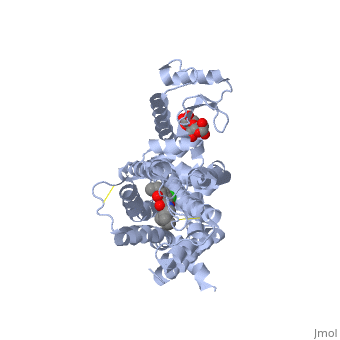User:Jessica Gauldin/Sandbox1
From Proteopedia
| Line 11: | Line 11: | ||
== Function == | == Function == | ||
| + | Dopamine is a neurotransmitter naturally found in the brain and acts specifically on dopamine receptors. It is classified as a catecholamine, meaning it is made from the amino acid, tyrosine. Dopamine is the precursor to both norepinephrine and epinephrine, which innervate the sympathetic nervous system, therefore its effects in the body are widespread (“Dopamine”). For instance, when these receptors are activated in the renal vasculature, this leads to renal blood vessel dilation, and an increase in glomerular filtration rate, renal blood flow, sodium excretion, and urine output. | ||
| + | |||
| + | Activation of dopamine receptors can either lead to an excitatory (D1, D5) or inhibitory (D2, D3, D4) response in the brain (Brown, 2015). When the excitatory receptors are activated, this activates adenylyl cyclase, a regulatory enzyme, which then increases the concentration of cAMP inside the cell (Dopamine Receptor). Activation of D2-like receptors generates an inhibitory response by preventing the formation of cAMP by inhibiting the adenylyl cyclase enzyme (Dopamine Receptor). | ||
== Ligands == | == Ligands == | ||
Revision as of 22:06, 16 November 2015
Dopamine Receptor
| |||||||||||
References
- ↑ Hanson, R. M., Prilusky, J., Renjian, Z., Nakane, T. and Sussman, J. L. (2013), JSmol and the Next-Generation Web-Based Representation of 3D Molecular Structure as Applied to Proteopedia. Isr. J. Chem., 53:207-216. doi:http://dx.doi.org/10.1002/ijch.201300024
- ↑ Herraez A. Biomolecules in the computer: Jmol to the rescue. Biochem Mol Biol Educ. 2006 Jul;34(4):255-61. doi: 10.1002/bmb.2006.494034042644. PMID:21638687 doi:10.1002/bmb.2006.494034042644
3. Beaulieu, Jean-Martin, and Gainetdinov, Raul R. "The Physiology, Signaling, and Pharmacology of Dopamine Receptors." Pharmacological Reviews 63.1 (2011): 182-217.
4. Brisch, Ralf, Arthur Saniotis, Rainer Wolf, Hendrik Bielau, Hans-Gert Bernstein, Johann Steiner, Bernhard Bogerts, Katharina Braun, Zbigniew Jankowski, Jaliya Kumaratilake, Maciej Henneberg, and Tomasz Gos. "The Role of Dopamine in Schizophrenia from a Neurobiological and Evolutionary Perspective: Old Fashioned, but Still in Vogue." Frontiers in Psychiatry. Frontiers Media S.A., 19 May 2014. Web. 16 Nov. 2015.
5. "Dopamine." Dopamine. PubChem, 24 Oct. 2015. Web. 27 Oct. 2015.
6. Kalani, M., Vaidehi, N., Hall, S., Trabanino, R., Freddolino, P., Kalani, M., Floriano, W., Kam, V., Goddard, W.(2004). The predicted 3D structure of the human D2 dopamine receptor and the binding site and binding affinities for agonists and antagonists. Proceedings of the National Academy of Sciences, 101(11), 3815-3820. doi:10.1073/pnas.0400100101
7. Kim, Jong-Hoon, and Johnathan Auerbach. "Dopamine Neurons Derived from Embryonic Stem Cells Function in an Animal Model of Parkinson's Disease." Nature.com. Nature Publishing Group, 4 July 2002. Web. 16 Nov. 2015.
8. Missale, C., Nash, S., Robinson, S., Jaber, M., & Caron, M. (1998). Dopamine Receptors: From Structure to Function. Physiological Reviews, 78(1), 189-225. 16 Nov 2015.
9. "Treatment Statistics." DrugFacts:. NIH, Mar. 2011. Web. 16 Nov. 2015.

